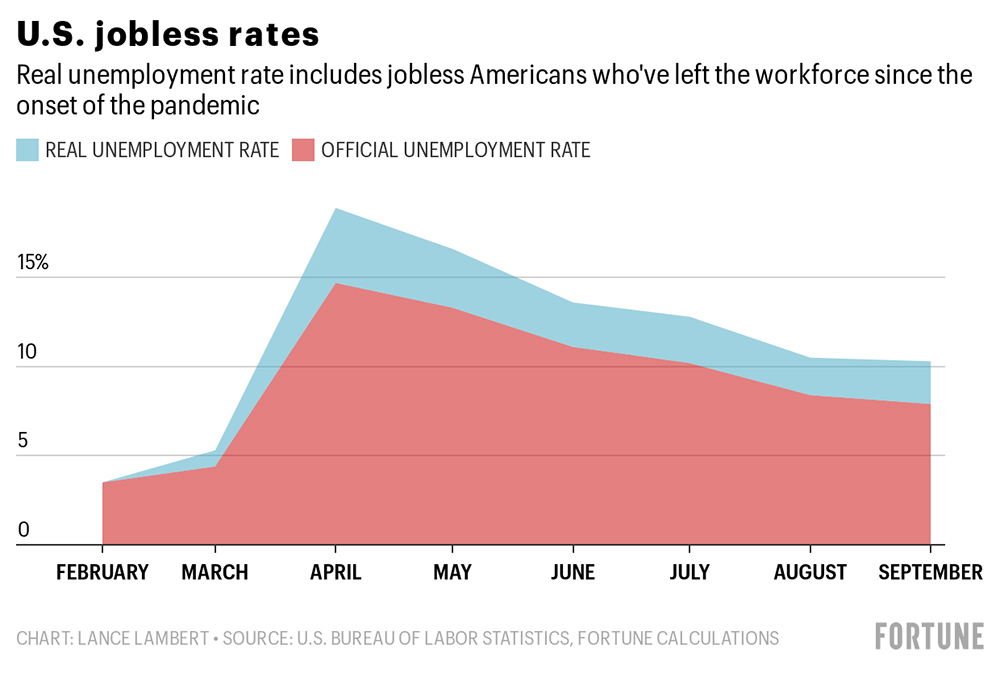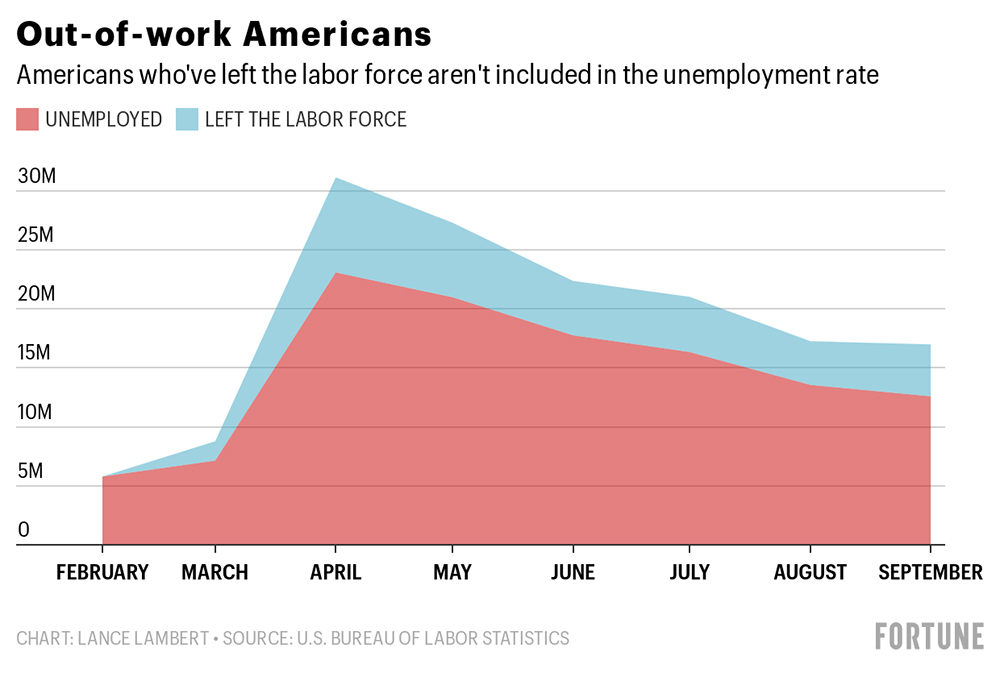美国的真实失业状况如何?比官方数据更糟糕
在今年4月疫情封锁措施最严格的时候,美国的失业率达到14.7%,是1940年以来的最高水平。但随着各州纷纷解封,失业率快速下降。9月的失业率再次下降,从8.4%降至7.9%。
虽然失业率持续下降意味着经济正在从衰退向增长转变,但美国对失业人数的统计可能存在严重不足。
根源在于美国劳工统计局(Bureau of Labor Statistics)计算官方失业率的方式:只有正在寻找新工作的失业美国人才会被归入失业人口。如果失业者没有在找工作,他们就会被排除在劳动力人口以外。(以美国失业人口数量除以劳动力人口得出失业率。)
在疫情期间一直是这样的情况。有数以百万计的美国失业者选择等到疫情结束和居家隔离令取消之后再去找工作。最近的数据还显示有许多女性离开了劳动力队伍,出现这种趋势的原因可能是许多学校还没有复课,或者采取了混合授课的方式。《财富》杂志的《The Broadsheet》专栏统计,在上个月的110万失业者中,有80%是女性。美国的劳动力人口从2月的1.645亿减少到4月的1.565亿。虽然后来恢复到1.601亿,但依旧比2月减少了440万人。

在计算失业率时,如果将尚未重回劳动力队伍的440万美国失业人口包含在内,可以得出《财富》杂志所说的“实际”失业率。据《财富》杂志计算,9月的实际失业率为10.3%。这一数字远高于劳工统计局计算的官方失业率7.9%。
实际失业率也在下降:4月的实际失业率达到最高点18.9%,当时的官方失业率为14.7%。但实际失业率依旧是较高的两位数,这表明经济完全复苏还有很长的路要走:2月的实际失业率和官方失业率均为3.5%。

在经济衰退期间,也有美国失业者离开了劳动力队伍,但远没有本次疫情期间这么严重。2009年10月,失业率达到大衰退时期的最高点10%。与此同时,按照《财富》杂志的计算,实际失业率为10.6%。2009年10月的劳动人口较前一年减少了约110万人,而2020年9月减少了440万人。(财富中文网)
翻译:刘进龙
审校:汪皓
在今年4月疫情封锁措施最严格的时候,美国的失业率达到14.7%,是1940年以来的最高水平。但随着各州纷纷解封,失业率快速下降。9月的失业率再次下降,从8.4%降至7.9%。
虽然失业率持续下降意味着经济正在从衰退向增长转变,但美国对失业人数的统计可能存在严重不足。
根源在于美国劳工统计局(Bureau of Labor Statistics)计算官方失业率的方式:只有正在寻找新工作的失业美国人才会被归入失业人口。如果失业者没有在找工作,他们就会被排除在劳动力人口以外。(以美国失业人口数量除以劳动力人口得出失业率。)
在疫情期间一直是这样的情况。有数以百万计的美国失业者选择等到疫情结束和居家隔离令取消之后再去找工作。最近的数据还显示有许多女性离开了劳动力队伍,出现这种趋势的原因可能是许多学校还没有复课,或者采取了混合授课的方式。《财富》杂志的《The Broadsheet》专栏统计,在上个月的110万失业者中,有80%是女性。美国的劳动力人口从2月的1.645亿减少到4月的1.565亿。虽然后来恢复到1.601亿,但依旧比2月减少了440万人。
在计算失业率时,如果将尚未重回劳动力队伍的440万美国失业人口包含在内,可以得出《财富》杂志所说的“实际”失业率。据《财富》杂志计算,9月的实际失业率为10.3%。这一数字远高于劳工统计局计算的官方失业率7.9%。
实际失业率也在下降:4月的实际失业率达到最高点18.9%,当时的官方失业率为14.7%。但实际失业率依旧是较高的两位数,这表明经济完全复苏还有很长的路要走:2月的实际失业率和官方失业率均为3.5%。
在经济衰退期间,也有美国失业者离开了劳动力队伍,但远没有本次疫情期间这么严重。2009年10月,失业率达到大衰退时期的最高点10%。与此同时,按照《财富》杂志的计算,实际失业率为10.6%。2009年10月的劳动人口较前一年减少了约110万人,而2020年9月减少了440万人。(财富中文网)
翻译:刘进龙
审校:汪皓
At the height of lockdowns the unemployment rate reached 14.7% in April, its highest level since 1940. But as states eased those restrictions, the rate quickly fell. It dropped again in September, falling from 8.4% to 7.9%.
While that sustained drop signals an economy moving from recession to growth, it's also severely undercounting joblessness.
It boils down to how the Bureau of Labor Statistics (BLS) calculates the official unemployment rate: Only out-of-work Americans who are searching for new positions are categorized as unemployed. If the jobless aren't searching, they get thrown out of the civilian labor force altogether. (The unemployment rate is calculated by dividing the number of unemployedAmericans by the civilian labor force count).
That's been the case during the pandemic, with millions of jobless Americans choosing to wait out the virus and stay-at-home order before starting their job search. Recent numbers also show a stunning number of women have recently left the workforce, a trend that is likely tied to the fact that many schools have not resumed in-person learning or have implemented hybrid schedules. According to Fortune's The Broadsheet newsletter, 80% of the 1.1 million workers who dropped out of the workforce last month were women. Overall the civilian labor force declined from 164.5 million in February to 156.5 million in April. It has since climbed up to 160.1 million—but it's still down 4.4 million.
If the 4.4 million jobless Americans who've yet to return to the workforce were to be included in the unemployment rate—what Fortune considers the "real" unemployment rate—it would sit at 10.3% in September, Fortunecalculates. That's well above the 7.9% official unemployment rate calculated by the BLS.
The real unemployment rate is falling too: It peaked at 18.9% in April, when the official unemployment rate was at 14.7%. But a real unemployment rate still sitting above double digits underscores that we have a long way to go for a full recovery: Both the real and official unemployment rates sat at 3.5% in February.
Jobless Americans often leave the workforce during deep recessions—but nothing on the level we've seen during the pandemic. The unemployment rate peaked at 10% in October 2009 during the Great Recession era. At the same time the real unemployment was 10.6%, according to Fortune's calculations. The October 2009 labor force was down about 1.1 million from the year prior—compared to the 4.4 million in September 2020.













